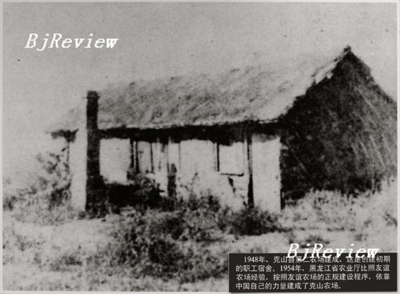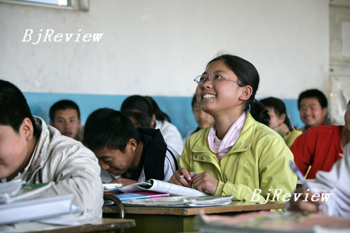| Home / China / Features | Tools: Save | Print | E-mail | Most Read |
| No Pain, No Grain |
| Adjust font size: |
By Lan Xinzhen Puyang Farm, 600 km from Harbin, capital city of Heilongjiang Province, is an ordinary plot among holdings in the Beidahuang reclamation area. Developed in 1971, it is now a state-owned mechanized major grain producer. There is nothing to tell of its past except for a sculpture at its entrance.
Nobody would associate the prosperous farm with the deserted wasteland it once was. There are four rivers running through the farm of which the Songhuajiang River is the largest. The underground water level is 2-3 meters and changes with the flow of the rivers, which used to break their banks flooding the area in spring and autumn before reclamation, leaving only weeds. Reclamation of the area began on October 3, 1970, when Lu Quansheng, head of Tangyuan Farm, led an eight-member team on the first field investigation of the swampland. They encountered "a vast wasteland in the mist," and "after we walked about 100 steps into the wasteland, thick weeds as tall as a person began to separate us like a tight wall, " according to a description of their exploration in The History of Puyang Farm. Members of the field team called to each other to keep in contact as they trod a path through the weeds, stopping to collect soil and vegetation samples. It took them three days to complete that first investigative trip and reach the end of the swampland.
"They discovered the wasteland was a fertile one and decided to reclaim it with a detailed reclamation plan," said Li Xiuying, a worker on the farm. "They also proposed to raise the banks of Songhuajiang River in order to lower the flood into the swampland." According to The History of Puyang Farm, the reclamation team opened up around 1,300 hectares, or 5 percent of the farm's total area in about one month before the land froze on November 11. On January 23 the following spring, nearly 2,000 residents from the adjacent Tangyuan Farm moved to the wasteland to establish a new holding, Puyang Farm. "They built on nothing but the opened land of 1,300 hectares, and made the layout on the spot with wicker, handkerchiefs and things they could find or take with them," said Li. "The most difficult part was their first meal on the wasteland, which took them five hours to prepare as the temperature was more than 30 degrees below zero," said Gu Yi, head of Puyang Farm today. "They had to dig into the frozen land to set up a boiler and melt ice and snow for water." The farm has developed at a speed of 2,000 hectares every year to today's size and was fully established in 1981.
Infestation Soon after its establishment, the farm experienced several major disasters. The first was a fire two months after it was first built, which 700 workers were mobilized to put out. That fire, and a second which took place half a month later, burned farm buildings and 300 hectares of woods nearby, leaving one dead and five injured. Then, there was a pest infestation. In June 1972, as the farm was nearing harvest time an army of worms invaded the corn fields, eating half of the crops before they could be controlled. In the spring of 1973, there was an ice flood when the Songhuajiang thawed. The flood left a mess and destroyed almost everything on the farm. "This flood made it imperative to reinforce the levee alongside Songhuajiang," said Gu. Supported by the Central Government, the Songhuajiang levee project was finished in 1976, and Puyang Farm has never been hit by a flood since. In 1977, Puyang Farm began to develop mechanized agriculture, and between 1977 and 2000 imported 300 machines from the United States, Germany and Japan. With these and 1,200 machines bought in China the farm achieved "totally mechanized production." In 2005, the farm imported 540 intelligent tractors with satellite positioning systems and digital remote control functions from the United States, and the following year invested more than 7 million yuan to update old machinery. An airfield was also built at the farm to accommodate planes for weeding, pest control, fertilization and monitoring the growth of crops. "Mechanized operations have greatly enhanced the farm's efficiency," said Cui Lijun, head of the farm's agricultural production section. "Today, six workers can finish the work that used to be done by 20 workers." "We had basically realized standardized production by the end of 1984," added Li. Mechanized and standardized production has led to increasing levels of grain production. The farm produced only 1,000 kg of rice or 750 kg of soybeans per hectare when it began, and now produces 7,500 kg of rice or 3,250 kg of soybeans per hectare. Puyang Farm reaped 193,000 tons of grain last year, accounting for 10 percent of total production in Beidahuang. Cozy place After dinner, residents of Puyang love to go for a walk in the square, which, the size of 50 basketball courts, and with its public gym equipment, is a popular place to hang out. The farm has all the facilities to make it a cozy place to live, with two Internet bars, a kindergarten, a primary school, a middle school, a library, a bank, a hospital, a hotel, a restaurant and a shopping center. It also enjoys convenient transportation, with sleeper buses heading for Harbin every day. Some Puyang residents live in villas, some in apartments and a small portion in single-storey houses. Many households use marsh gas and only senior residents remember the days when the locals slept in horse sheds. "Urbanization is the focus of our job today with emphasis on the service industry," explained Gu. The development of mechanized farming in Puyang Farm has liberated two thirds of the agricultural population. In order to provide employment for the surplus agricultural labor force, there are plans to develop agricultural product processing companies and the service industry over the next five years. There are also plans to build housing projects to move residents still living in poor single-storey blocks into new high-rise buildings. According to Gu, the farm still has production teams separated like villages far away from the town, making it inconvenient for them to seek medical care and education, and this group of people will move to the town in the near future. The farm is also experiencing an influx of migrant workers who will also need accommodation. According to Gu the farm has invested 10 million yuan into the urbanization project. "You will see huge changes if you come back in a couple of years," he said.
(Beijing Review June 29, 2007) |
| Tools: Save | Print | E-mail | Most Read |
 |
| Related Stories |



